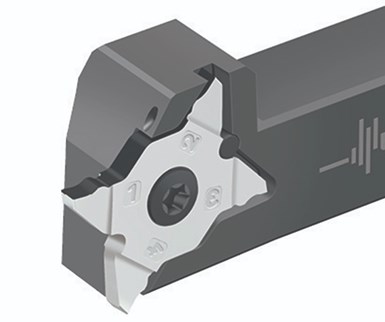Walter USA's G3051-P Arranges Inserts for Efficient Grooving Along Shoulders
Walter USA’s G3051-P grooving system, designed for grooving along shoulders, uses MX22-2L/R indexable inserts inclined by 3 degrees in the insert pocket.
Share






Walter USA’s G3051-P grooving system uses MX22-2L/R indexable inserts inclined by 3 degrees to enable deep grooving operations along the shoulder. The four-edged MX inserts are available with Walter’s GD8 and VG8 geometries.
The GD8 geometry was developed for grooving along shoulders and grooving large diameters without interference of the insert with the finished workpiece. The VG8 geometry was designed for finishing operations behind a collar. The company says that its narrow shape reduces space requirements and saves material in mass production when compared to V-style ISO turning inserts.
The G3051-P grooving system can be used on CNC lathes and multi-spindle machines as well as automatic lathes. These holders, available in shank sizes of 0.625" to 1.0" and 12 to 25 mm, are designed with Walter’s precision cooling feature. The holders enable cutting depths ranging to 0.197" (5 mm), with insert widths ranging from 0.059" 0.118" (1.5 to 3 mm). The technology is particularly suited to high-volume production of smaller components, such as camshafts in the automotive industry and precision parts in the medical device industry.
The MX inserts’ large contact surfaces and dowel pin location contribute to stability, precision and indexing accuracy. The tangential arrangement of the grooving inserts is said to provide flatness and promote good surface quality.
Related Content
-
Custom PCD Tools Extend Shop’s Tool Life Upward of Ten Times
Adopting PCD tooling has extended FT Precision’s tool life from days to months — and the test drill is still going strong.
-
The Future of High Feed Milling in Modern Manufacturing
Achieve higher metal removal rates and enhanced predictability with ISCAR’s advanced high-feed milling tools — optimized for today’s competitive global market.
-
How to Troubleshoot Issues With Tool Life
Diagnosing when a tool is failing is important because it sets an expectation and a benchmark for improvements. Finding out why gives us a clue for how to fix it.












